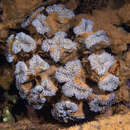en
names in breadcrumbs


Euphyllia cristata is commonly called grape coral. E. cristata is a kind of stony or hard coral in the family Euphylliidae; it also belongs to the genus Euphyllia in the order of Scleractinia.[2] E. cristata has a wide range of distribution throughout the tropical waters of the Indo-West Pacific area with a large presence in Indonesia.[3] However, despite this large range of distribution, E. cristata has a slightly lower abundance compared to other species, making them a little more uncommon to find.[2][4] They are typically found in shallow waters from 1–35 meters deep.[5][2]
Euphyllia cristata was first documented by Chevalier in 1971.[2][3] E. cristata is a Cnidaria of the class Anthozoa and of the order of Scleractinia. Scleractinia are hard corals. E. cristata live in small sized phaceloid colonies, which is a particular type of spatial formation and organisation, where corallites are elongate, distinctive tube-like, and between 20 and 40 millimetres (1.6 in) diameter.[6]
E. cristata has a wide range of distribution in the Indo-Western Pacific.[7] Their range of distribution also includes the Coral Triangle and the Great Barrier Reef.[3][2][8] Even though E. cristata’s distribution is diverse, it is absent from the Red Sea.[2] E. cristata is found on hard substrates.[7] In addition, they are found in a depth of 1–35 meters below the surface.[7][2]
The International Union for Conservation Nature and Natural Resources (IUCN) classified the Red List status of the E. cristata as vulnerable in 2008.[2] In addition, many of the other Euphilids have been classified as threatened by the IUCN.[2][5] There are many threats to the populations of E. cristata. As a result of E. cristata being a colorful stony coral with big polyps, it has been sought after for jewelry.[9][10][5][2] E. cristata is also faced with having to adapt to changes in mean tide levels, changes in wave action, increases in water temperature, ocean acidification, fisheries, exposure to pollution, and erosion.[2][4][11][7][10][9][5] These things increase the frequencies of bleaching and increase the susceptibility of the coral to disease.[2]
Euphyllia cristata is commonly called grape coral. E. cristata is a kind of stony or hard coral in the family Euphylliidae; it also belongs to the genus Euphyllia in the order of Scleractinia. E. cristata has a wide range of distribution throughout the tropical waters of the Indo-West Pacific area with a large presence in Indonesia. However, despite this large range of distribution, E. cristata has a slightly lower abundance compared to other species, making them a little more uncommon to find. They are typically found in shallow waters from 1–35 meters deep.